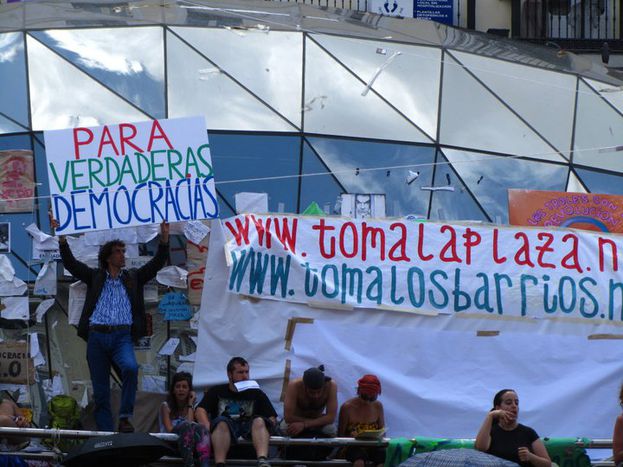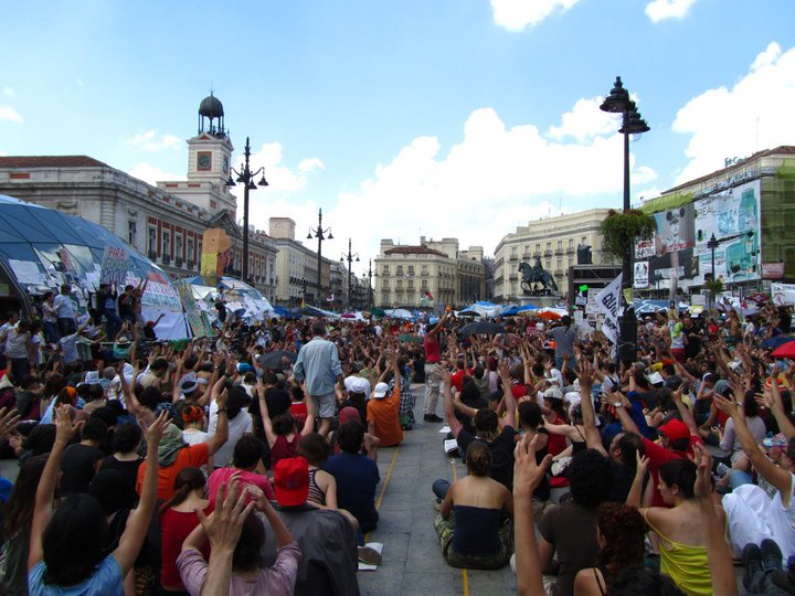
THE 15-m REVOLUTION LEGACY
Published on
Translation by:
Samantha KelloggEvery new election period reveals the effective bipartisanship that exists in our country, despite the emergence of a great variety of new, short-lived parties. The 15-M revolution meant a fundamental shift in Spanish culture without knowing, to this date, the immediate political consequences. Is a metamorphosis in Spanish political life to be expected?
The question that one asks, viewing the proliferation of civic associations (better known as civic tides), of marches for dignity, of processions and protests against the law that restricts abortion rights or our own freedom of asociation and assembly is, Why doesn't a political leader, who can be the voice and vote of these wounded and unhinged citizens from Brussels to Moncloa, appear?
The answer, far from simple, could be summarised in the variety of those Puerta del Sol concessions in May of 2011, the never-ending year.
That month showed the flip side of the coin or rather, what's behind the mirror, where the faces of José Luis Zapatero, José María Aznar, Felipe González, Leopoldo Calvo-Sotelo and Adolfo Suárez reflected a drained, dark and decadent political system. My opponents replied that this system will outlast me and I'm sorry to have to agree, despite my longing to see my country transform into an example of democracy and transparency.
Make no mistake about it, this article's intention is not to be a pamphlet against our government's past presidents; I want to have faith that “God will recognize his own”. Rather, it's about paying attention to the civic initiative of the so-called “indignados” and to respect their restlessness. It has sought to condemn the political “status quo” impeding polarisation for almost 40 years.
Let's get back to Puerta del Sol (Madrid's most famous square), witness to the uneasiness of my countrymen. That May, of 2011, many proposals were heard, whether they were political, social, environmental or economic. The vast majority possessed virtues of being original and innovative, which went well beyond being left or right-wing.
How can those town meetings in Puerta del Sol be forgotten; witnessing the birth of proposals such as “a house and a job for all”, the replacement of austerity with public investments, the energy transition development, the growth of utilities, the fight against fiscal evasion, the extermination of corruption, the impulse to tax currency transactions (the Tobin tax)...I remember, with pride and some sadness, those days of uprising and social change; something changed at that time.
But in creating a political party that brings aforementioned aspirations to the forefront, not just one political party appears, but many. In this way, the traditional political parties pave the way, observing Julius Caesar's famous refrain “divide et impera” (divide and conquer) to the letter.
 Ideologically, let us not fool ourselves, we all know that several political sources invaded Puerta del Sol, Bilbao Arenal, Gran Vía de Colon in Granada, Fuente Dorada square in Valladolid, Catalonia square in Barcelona...And obviously, for all of these people to reach an agreement is nearly impossible. This is precisely how the PP (The People's Party) and the PSOE (The Spanish Socialist Workers' Party) still live and eat today, by our inability to join forces and impose a farewell to our, regrettably very present, political past and project ourselves into the future of “real democracy” - whose motto, well known to all the “indignados” (the Spanish equivalent of the Occupy movement), must be a turning point of coming, political change in Spain.
Ideologically, let us not fool ourselves, we all know that several political sources invaded Puerta del Sol, Bilbao Arenal, Gran Vía de Colon in Granada, Fuente Dorada square in Valladolid, Catalonia square in Barcelona...And obviously, for all of these people to reach an agreement is nearly impossible. This is precisely how the PP (The People's Party) and the PSOE (The Spanish Socialist Workers' Party) still live and eat today, by our inability to join forces and impose a farewell to our, regrettably very present, political past and project ourselves into the future of “real democracy” - whose motto, well known to all the “indignados” (the Spanish equivalent of the Occupy movement), must be a turning point of coming, political change in Spain.
Indecisiveness will be the tomb of the citizen's revolution; in order to exisit politically a common list of candidates would have to be agreed upon and the different think tanks groups, that came into being at the citizens' initiative in May of 2011, would be at the service of the Spanish, political renaissance. I am asking, United Left, Podemos, Partido X, Party of the Citizens, The Greens, EQUO and all the political parties that identify with the 15-M revolution legacy to gather and work hand in hand, as a symbol of a country united in diversity, just as millions of citizens did at that time, marching for dignity.
Translated from La herencia de la revolucion del 15-M



